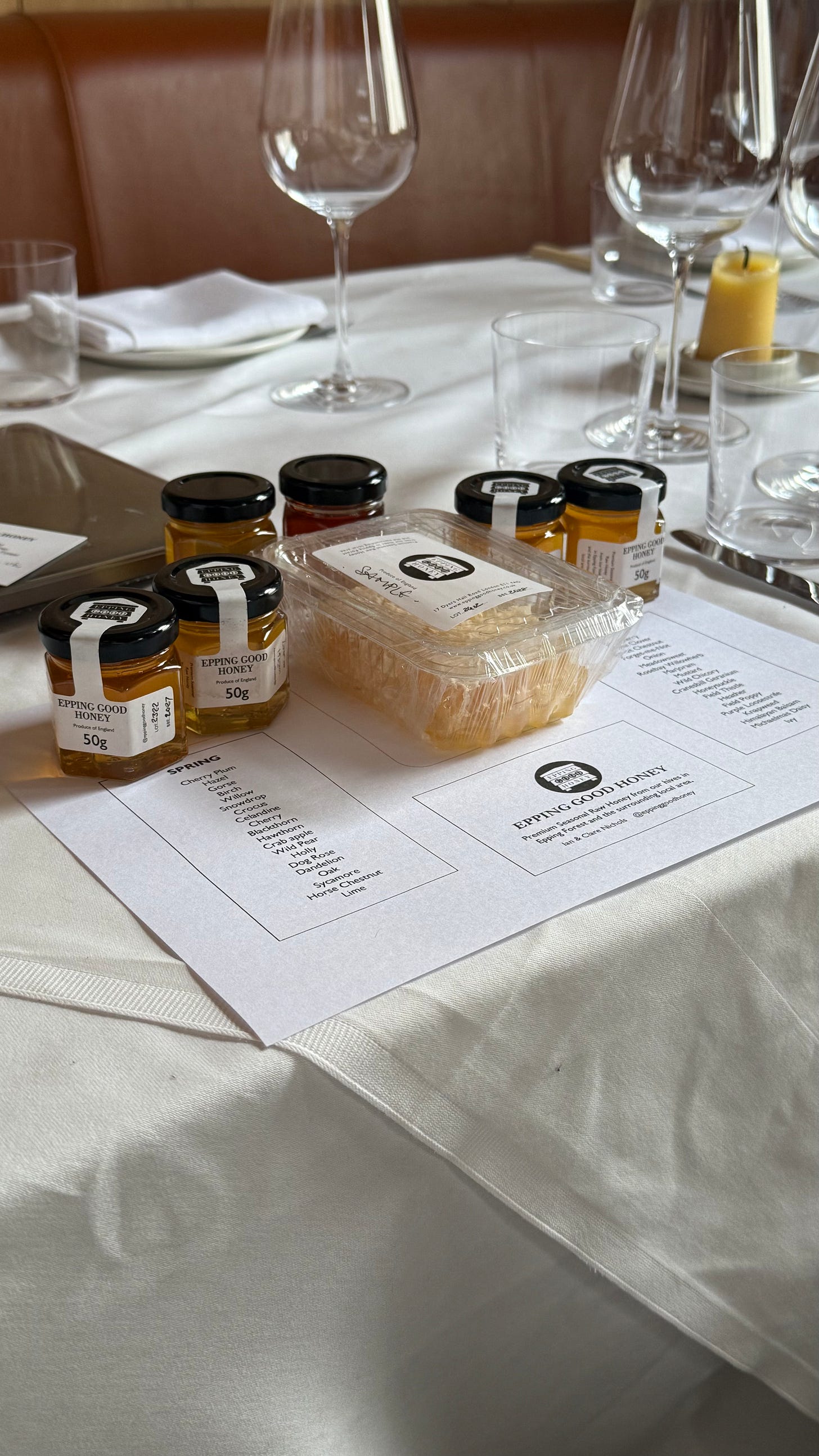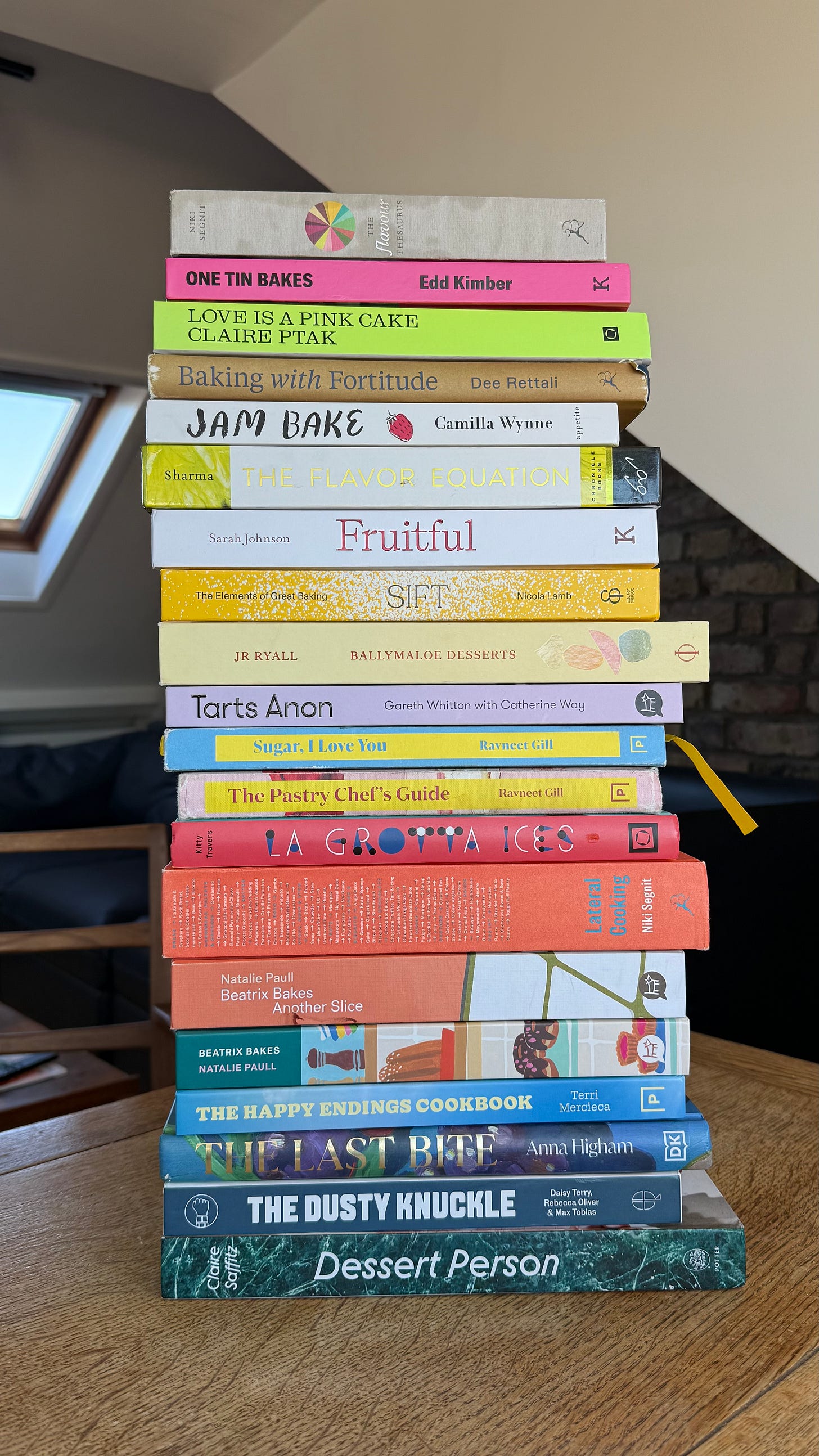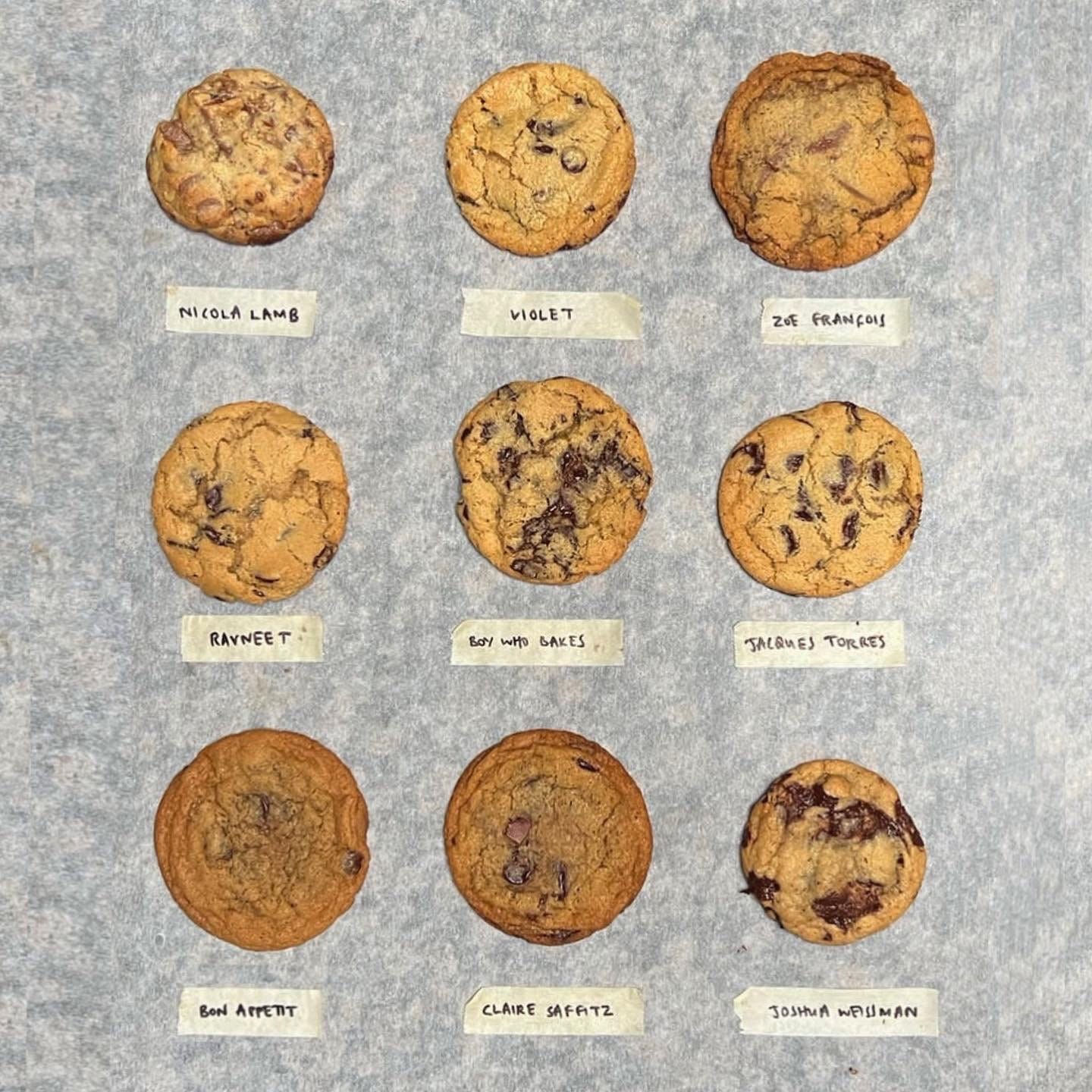What I’m reading: Uses for Obsession, by Ben Shewry. Very kindly sent to me by my friend Mary, this is a memoir by New Zealand chef/restauranteur/owner of the Melbourne restaurant Attica. I couldn’t put it down.
What I’m listening to: like the rest of Ireland, I was briefly caught up in part 3 of the GAA Catfish story, as told on the 2 Johnnies’ podcast
What I’m eating: Epping Good Honey, from Epping Forest - samples very kindly brought to us by Claire (below)
I think it’s safe to say that I’m obsessed with cookbooks. I have loved cookbooks since I was a small child, and would read them (repeatedly) cover to cover, taking out cookbooks from the library and lying on the floor, poring over the recipes, photos and illustrations avidly. They sit quite neatly at the intersection of so many of my interests: cooking, baking, writing, reading, photography, design and PRINT (iykyk).
I love when restaurants and cafes have cookbooks sitting proudly on their shelves, showing customers the influences behind the menu. To me, it’s an expression of humility: we all draw inspiration from a wide range of sources, but one of the best places to start is a cookbook, where you can safely assume that the person who wrote it is an authority in their chosen area.
The recipe writing world is an interesting one, because a lot of recipes are very similar. There’s only so many configurations of a scone or a brownie you can make, without re-inventing the wheel, or adding outlandish ingredients. I find that most of the time, the pros have done a lot of the legwork for us: they’ve trialled different ratios of ingredients, mixing methods, equipment and baking temperatures, and delivered the results to us, neatly packaged in a beautiful cookbook.
When I was doing a lot of recipe testing involving making 6 or 9 of the same recipe (see below), I found that when you broke down the recipes, there was very often a clear blueprint. For example, the 1:1:1:1 proportions for frangipane (butter, sugar, ground almonds) is a good starting point, and any alterations beyond that are usually down to personal preference, or to achieve a particular result. I thought it was really funny (hilarious, actually) that when I made 9 banana breads in a day, most of them went for a one egg per banana ratio. Of course, tiny alterations can make a huge difference to the results, but I often find that the rules are the rules for a reason. That’s why I enjoy the challenge of making 9 different recipes for the same baked goods in one day: you get a really good feel for what works and what doesn’t, so when it comes to writing your own recipe, you know which steps to skip, and which methods provide the best results. My own recipe might contain the butter:sugar ratio of one recipe, the mixing method of another, the baking temp of another, the decoration suggestion of another - maybe with a different flour swapped in, and finished using my favourite buttercream recipe, which is also adapted from another recipe. So while this does sometimes give me an existential crisis about intellectual property, I do think that when it comes to recipes, we are all standing on the shoulders of those who came before us - and I am eternally grateful to all of the creative, talented, intelligent people who have written cookbooks so that we can all share in the fun.
This list is in no particular order: it’s just the collection I currently have in my rotation, and have deemed important enough to transport to London to sit on the tiny bookshelf in my tiny room. I have a long wishlist of books in my Notes app (and may actually treat myself to one today because it’s PAYDAY), but I can honestly say that I’ve read/used each and every one of these cookbooks, and return to some of them frequently (even if it’s just to look at the pretty pictures).
my fave cookbooks
Jam Bake, by Camilla Wynne
This book contains not only a multitude of recipes for jam and marmalade (Camilla is the preserving queen), but also recipes for what to do with them! The Cherry Negroni Jam Swirl Ice Cream is pretty high up on my list of things to make, and I followed the Seville Orange Marmalade recipe closely when making a big batch last week.
Baking With Fortitude, by Dee Rettali
I love Fortitude and I love this book (and I also love Dee). I was lucky enough to work at Fortitude for a couple of weeks a few years ago, and I have a huge amount of respect for everything they do. Make the sticky cinnamon buns, and thank me later. I’m also a big fan of the photography in this book (shot masterfully by Laura Edwards).
Love is a Pink Cake, by Claire Ptak
This book is strikingly beautiful: half of it is shot in California, and half in London (and I believe a lot of it on a film camera). The recipes are gorgeous too - I included the Fig Tartlets with Crushed Almond Frangipane in one of my recipe tests for the Irish Times, and they turned out perfectly.
One Tin Bakes, by Edd Kimber
Edd Kimber’s recipes just work. This is a great book with loads of recipes that only require a standard (23x33cm) baking tin. I made the Tahini Chocolate Chip Cookie Bars a while ago, and consider Edd an authority on particularly anything in the blondie/brownie category.
The Flavour Thesaurus, by Niki Segnit
For me, this book is absolutely essential. It does pretty much what it says in the tin - you can look up pretty much any ingredient, and it will give you a list of other ingredients/flavours that will complement it.
The Flavour Equation, by Nik Sharma
This book is great for anybody that wants to gain a deeper understanding of food science. It’s got a whole section at the start that explains various elements of cooking (mouthfeel, aroma, taste etc.) and then 7 whole chapters of recipes. Lots of fun graphs and charts too.
Fruitful, by Sarah Johnson
One of the first places I go when I need fruit inspiration. Sarah’s book is so detailed in its descriptions of how to prepare, preserve and cook with fruit, and includes a lot of really thoughtful recipes, including the Almond Marmalade Cake that I am dying to make.
Sift, by Nicola Lamb
I feel like every pastry chef in the world was waiting with bated breath for this one last year - and with good reason. Nicola has done a monumental amount of research, and condensed it down into this incredibly comprehensive book, equally suitable for home bakers and professionals. The bread and butter pudding recipe is second to none.
Ballymaloe Desserts, by JR Ryall
I love this book so much. It was launched the week I started working at Ballymaloe House, and I had the privilege of being taught most of these recipes by JR himself. It’s shot by Cliodhna Prendergast, so the photography is beautiful. Favourites include the Nearly-Molten Chocolate Tart and the Almond Praline Cake.
Tarts Anon, by Gareth Whitton with Catherine Way
This one is quite new to my collection, so I haven’t actually tried it, but I’ve heard wonderful things. I’ve got my eye on the Honey and Almond Shortbread Tart.
Sugar, I Love You, by Ravneet Gill
Ravneet’s second book, and there are some absolute corkers of recipes in here. The Cherry and Ricotta cake is a winner, and I’ve made it with a few different types of fruit. Also - whenever I see the Miso Caramel and Chocolate Tart with a Crunchy Cereal Base on Instagram, I think to myself, wow Beth you’ve got to make that, and then I never do. Soon.
The Pastry Chef’s Guide, by Ravneet Gill
Ravneet’s first book (I don’t know why I put them in this order) - it’s a really helpful and accessible guide to all the pastry basics. I particularly love the choux and Galette des Rois recipes.
La Grotta Ices, by Kitty Travers
This has become one of two go-to reference books for ice-cream (see below for the other one). Pistachio is a personal fave.
Lateral Cooking, by Niki Segnit
This is another really useful reference book, and the concept is very cool: Niki teaches “cooking sideways”, where he strips classic recipes down to the basics, before using those elements as building blocks to build a whole plethora of other things.
Beatrix Bakes: Another Slice, by Natalie Paull
Again, I’ve done this in a weird order - this is Natalie’s second book, and it contains some really wonderful recipes like the Salty Sweet Lime Crisp Sandwiches that we used to make at Mor.
Beatrix Bakes, by Natalie Paull
Natalie’s first book is one of my all-time favourites, so much so that I believe I somehow have two copies in my collection. My favourite thing about Natalie’s books is how accessible they are: they include really useful tips for home bakers, and there’s an “Adaptrix” column accompanying each recipe, offering alternatives for ingredient substitutions.
The Happy Endings Cookbook, by Terri Mercieca
The other ice-cream book I regularly refer to: I’ve never actually eaten a Happy Endings ice-cream (which is a sin), but I have complete and utter faith in Terri’s recipes. I’m dying to try the Fig Leaf Ice-cream (served with Fig Jam in a Brown Butter and Almond biscuit ice-cream sandwich). Heaven.
The Last Bite, by Anna Higham
One of my favourite reference books for fruit, as it’s completely based on the seasons. The Gooseberry Sherbet with Fool and Oat Biscuit is a wonderful way to celebrate gooseberry season.
The Dusty Knuckle Cookbook, by Daisy Terry, Rebecca Oliver and Max Tobias
The Dusty Knuckle make perhaps my favourite sourdough in London, and I use this book as a reference point whenever I decide it’s time for another foray into sourdough baking (and actually I think I’m overdue my next adventure). The white potato sourdough is one of the best breads in the world (although tbh, I usually just go buy it these days), and they also have plenty of good sandwich inspiration.
Dessert Person, by Claire Saffitz
I love Claire’s baking, and this is one of the only American baking books I own (primarily because she has very kindly translated every single recipe into the metric system). The Foolproof Tarte Tatin is indeed foolproof and I love the Blood Orange and Olive Oil Upside-Down Cake.
There are a few more that are on my wishlist, including ones that I’ve owned and lost, or borrowed from the library (and extended multiple times). These include:
Natasha Pickowicz’ wonderful book More Than Cake, which includes several recipes that I’ve made, like the black sesame chiffon and frosting (below)
Nicole Rucker’s book Fat and Flour which I have pre-ordered for April
All of Alison Roman’s books
McGee on Food and Cooking: An Encyclopedia of Kitchen Science, History and Culture, by Harold McGee, for a thorough scientific narrative on whatever you’re cooking
Zöe Bakes Cakes, by Zöe François, for wonderful cake recipes and inspiration
I’d love to hear any recommendations you have for the cookbooks that make up your collection! Thank you for reading, and I’ll see you next week x








Brilliant Boo xx